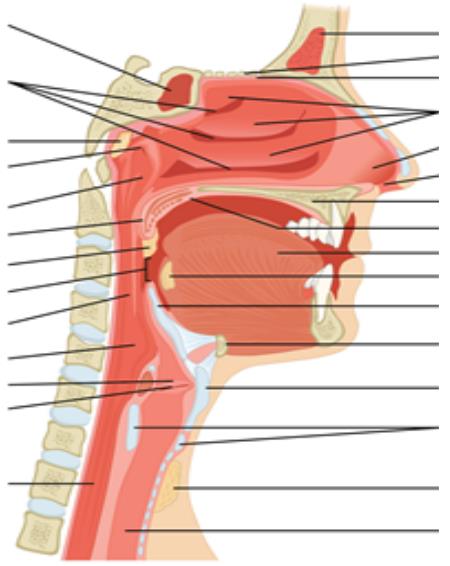Review Questions
- Select the term which best fits the description below. Write the word next to the statement selected.
External respiration Lower Internal Cellular respiration Upper
Laryngopharynx Glottis Meatus Hard palate Pharyngeal
Oropharynx Conchae Cribriform Gas exchange Septum
__________________ 1. Key process for making ATP.
__________________ 2. From the nasal cavity to the larynx.
__________________ 3. The primary function of the respiratory system.
__________________ 4. Gas exchange at the level of the tissues.
__________________ 5. These tonsils are closest to the internal nares
__________________ 6. This part of the pharynx is closest to the esophagus.
__________________ 7. Divides the nasal cavity into right and left regions.
__________________ 8. Three bony structures involved in warming incoming air.
__________________ 9. Gas exchange between the lungs and blood.
__________________ 10. Air passages between nasal conchae.
__________________ 11. Prevents food from getting into the larynx
__________________ 12. From the larynx to the alveoli.
__________________ 13. Part of the roof of the nasal cavity.
__________________ 14. Forms the floor of the nasal cavity
__________________ 15. Part of the pharynx closest to the oral cavity.
Larynx and bronchial tree
2. Complete each sentence with the most appropriate term(s).
1. The conducting part of the bronchial tree include, from the larynx, ___________________, ____________________ bronchi, secondary bronchi, ________________________ bronchi and bronchioles.
2. These laryngeal cartilages are paired. ___________________, ____________________ and _______________.
3. These cartilages are unpaired. ___________________, ____________________ and _____________________..
4. This is the only laryngeal cartilage not made up of hyaline cartilage. ____________________.
5. ________________ bronchi divide into __________________ bronchi which divide into _______________ bronchi.
6. The trachea and bronchi have many __________________ cells capable of removing material from the lower respiratory tract.
7. The respiratory membrane is made up of ____________________. _________________ and ____________________.
8. The _________________ cartilage is the largest, while the ___________________ cartilage is the only complete ringed cartilage.
9. The respiratory part of the bronchial tree include ________________, ____________________. ________________, and alveoli.
10. ________________________ pneumocytes make __________________ while __________________ pneumocytes forms most of the alveolar sacs.
11. The right lung has ______________ lobes while the left lung has ______________ lobes and a _______________________ where the left ventricle is located.
12. The right lung has ______________ and _____________ fissures separating the three lobes while the left lung has ______________ fissure separating the two lobes.
3.0 Match the structure to the correct description.
Parietal pleura
Pleural cavity
Visceral pleura
Serous
Diaphragm
Pneumothorax
Hemothorax
- ___________This membrane is attached to the lungs.
- ___________Blood in the pleural cavity.
- ___________ This membrane is closer to the thoracic wall.
- ___________This pleural membrane moves with the lungs during breathing.
- ___________Space between the visceral and parietal pleura.
- ___________This muscle is the primary muscle for inhalation.
- ___________Air within the pleural cavity.
- ___________ Both the parietal and visceral pleura are examples of this type of membrane.
4.0 List the structures involved in conducting and exchange of oxygen from the nostrils to the tissue.
5.0 List the structures involved in the exchange and conducting of carbon dioxide from the tissues to the nostrils.
6.0 Label the following diagram. Copying and pasting figures from other resources is not allowed.
7.0 Label the following parts
Trachea thyroid cartilage right primary bronchus diaphragm
Larynx right posterior lobe Left middle lobe Left primary bronchus
Research
Write a short essay on one of the diseases or disorders affecting the respiratory system. Be sure to include one or more sources. All sources must be written using one of the well-known formats.





